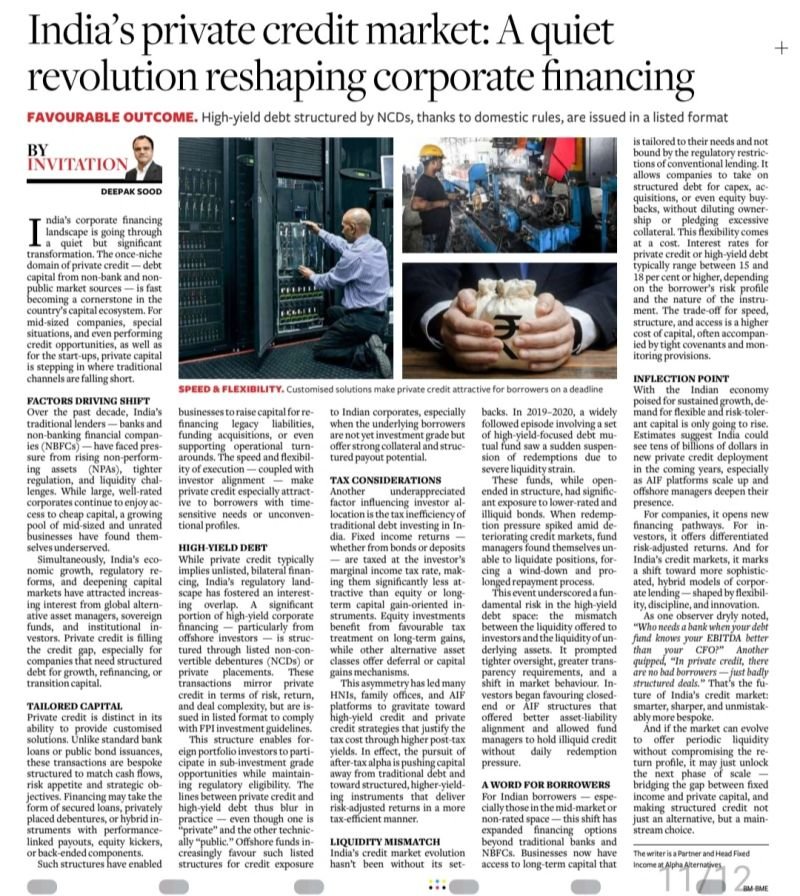
India’s private credit market: A quiet revolution reshaping corporate financing
Monday 26 May 2025
FAVOURABLE OUTCOME. High-yield debt structured by NCDs, thanks to domestic rules, are issued in a listed format
India’s corporate financing landscape is going through a quiet but significant transformation. The once-niche domain of private credit- debt capital from non-bank and non- public market sources-is fast becoming a cornerstone in the country’s capital ecosystem. For mid-sized companies, special situations, and even performing credit opportunities, as well as for the start-ups, private capital is stepping in where traditional channels are falling short.
FACTORS DRIVING SHIFT
Over the past decade, India’s traditional lenders-banks and non-banking financial companies (NBFCs)-have faced pressure from rising non-performing assets (NPAs), tighter regulation, and liquidity challenges. While large, well-rated corporates continue to enjoy access to cheap capital, a growing pool of mid-sized and unrated businesses have found them- selves underserved.
Simultaneously, India’s eco- nomic growth, regulatory re- forms, and deepening capital markets have attracted increasing interest from global alternative asset managers, sovereign funds, and institutional investors. Private credit is filling the credit gap, especially for companies that need structured debt for growth, refinancing, or transition capital.
TAILORED CAPITAL
Private credit is distinct in its ability to provide customised solutions. Unlike standard bank loans or public bond issuances, these transactions are bespoke structured to match cash flows, risk appetite and strategic objectives. Financing may take the form of secured loans, privately placed debentures, or hybrid instruments with performance linked payouts, equity kickers, or back-ended components.
Such structures have enabled businesses to raise capital for re- financing legacy liabilities, funding acquisitions, or even supporting operational turn- arounds. The speed and flexibility of execution-coupled with investor alignment make private credit especially attractive to borrowers with time- sensitive needs or unconventional profiles.
HIGH-YIELD DEBT
While private credit typically implies unlisted, bilateral financing, India’s regulatory land- scape has fostered an interesting overlap. A significant portion of high-yield corporate financing – particularly from offshore investors is structured through listed non-con- veritable debentures (NCDs) or private placements. These transactions mirror private credit in terms of risk, return, and deal complexity, but are issued in listed format to comply with FPI investment guidelines.
This structure enables foreign portfolio investors to participate in sub-investment grade opportunities while maintaining regulatory eligibility. The lines between private credit and high-yield debt thus blur in practice – even though one is “private” and the other technic- ally “public.” Offshore funds increasingly favour such listed structures for credit exposure
to Indian corporates, especially when the underlying borrowers are not yet investment grade but offer strong collateral and structured payout potential.
TAX CONSIDERATIONS
Another underappreciated factor influencing investor al- location is the tax inefficiency of traditional debt investing in In- dia. Fixed income returns – whether from bonds or deposits
are taxed at the investor’s marginal income tax rate, making them significantly less at- tractive than equity or long- term capital gain-oriented instruments. Equity investments benefit from favourable tax treatment on long-term gains, while other alternative asset classes offer deferral or capital gains mechanisms.
This asymmetry has led many HNIS, family offices, and AIF platforms to gravitate toward high-yield credit and private credit strategies that justify the tax cost through higher post-tax yields. In effect, the pursuit of after-tax alpha is pushing capital away from traditional debt and toward structured, higher-yielding instruments that deliver risk-adjusted returns in a more tax-efficient manner.
LIQUIDITY MISMATCH
India’s credit market evolution hasn’t been without its setbacks. In 2019-2020, a widely followed episode involving a set of high-yield-focused debt mutual fund saw a sudden suspension of redemptions due to severe liquidity strain.
These funds, while open- ended in structure, had significant exposure to lower-rated and illiquid bonds. When redemption pressure spiked amid deteriorating credit markets, fund managers found themselves un- able to liquidate positions, forcing a wind-down and pro- longed repayment process.
This event underscored a fundamental risk in the high-yield debt space: the mismatch between the liquidity offered to investors and the liquidity of underlying assets. It prompted tighter oversight, greater transparency requirements, and a shift in market behaviour. Investors began favouring closed- end or AIF structures that offered better asset-liability alignment and allowed fund managers to hold illiquid credit without daily redemption pressure.
A WORD FOR BORROWERS
For Indian borrowers – especially those in the mid-market or non-rated space-this shift has expanded financing options beyond traditional banks and NBFCs. Businesses now have access to long-term capital that
is tailored to their needs and not bound by the regulatory restrictions of conventional lending. It allows companies to take on structured debt for capex, acquisitions, or even equity buy- backs, without diluting owner- ship or pledging excessive collateral. This flexibility comes at a cost. Interest rates for private credit or high-yield debt typically range between 15 and 18 per cent or higher, depending on the borrower’s risk profile and the nature of the instrument. The trade-off for speed, structure, and access is a higher cost of capital, often accompanied by tight covenants and monitoring provisions.
INFLECTION POINT
With the Indian economy poised for sustained growth, de mand for flexible and risk-tolerant capital is only going to rise. Estimates suggest India could see tens of billions of dollars in new private credit deployment in the coming years, especially as AIF platforms scale up and offshore managers deepen their presence.
For companies, it opens new financing pathways. For investors, it offers differentiated risk-adjusted returns. And for India’s credit markets, it marks a shift toward more sophisticated, hybrid models of corporate lending-shaped by flexibility, discipline, and innovation.
As one observer dryly noted, “Who needs a bank when your debt fund knows your EBITDA better than your CFO?” Another quipped, “In private credit, there are no bad borrowers-just badly structured deals.” That’s the future of India’s credit market: smarter, sharper, and unmistakably more bespoke.
And if the market can evolve to offer periodic liquidity without compromising the re- turn profile, it may just unlock the next phase of scale- bridging the gap between fixed income and private capital, and making structured credit not just an alternative, but a main- stream choice.
Disclaimer: An investment with Alpha Alternatives (including its subsidiaries) is suitable only for sophisticated investors and requires the financial ability and willingness to accept the high risks and lack of liquidity inherent in any such investment. This document is not intended to be comprehensive or to provide specific investment advice or services. The document is not in any form a substitute for such professional advice or services, and it should not be acted on or relied upon or used as a basis for any decision or action that may affect you or your business. Before deciding to invest, prospective investors should read the definitive offering and subscription documents and pay particular attention to the risk factors contained therein. Persons who are not relevant persons must not act on or rely on this document or any of its contents. Any investment or investment activity to which this document relates is available only to relevant people and will be engaged only with relevant people. Any decision or action taken by you based on the information contained herein is your responsibility, and Alpha Alternatives is not liable in any manner for the consequences of such a decision or action. In deciding whether to make an investment with Alpha Alternatives, you must rely on your own evaluation of the terms of the proposed investment and the merits and risks involved, and, if applicable, upon receipt and careful review of any confidential memorandum, prospectus, or similar documents, and you should consult your legal, tax, investment, or other advisor. The contents of this document do not constitute and should not be construed as legal, tax, or investment advice. Although Alpha Alternatives has used all reasonable efforts to ensure that the information provided in this document is correct, Alpha Alternatives and its members, partners, stockholders, managers, directors, officers, employees, advisers, representatives, and agents make no representation and give no warranty that such information is accurate, complete or current, and you should not rely on the information provided in this document for any purpose.







































